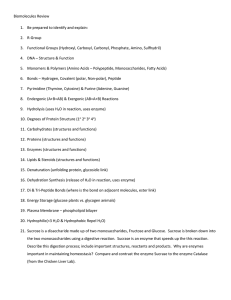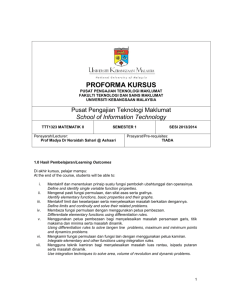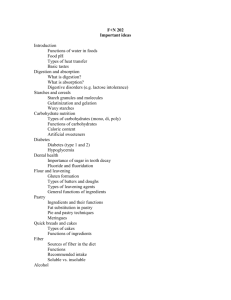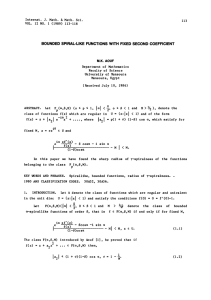Approximating Submodular Functions Everywhere Nick Harvey October 4th, 2009
advertisement
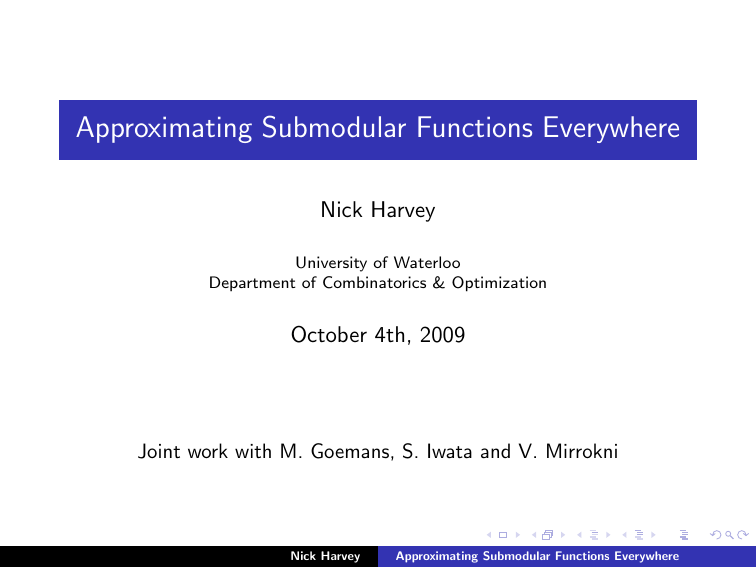
Approximating Submodular Functions Everywhere
Nick Harvey
University of Waterloo
Department of Combinatorics & Optimization
October 4th, 2009
Joint work with M. Goemans, S. Iwata and V. Mirrokni
Nick Harvey
Approximating Submodular Functions Everywhere
Motivating Example
I
Microsoft Office consists of a set A of products.
e.g., A = {Word, Excel, Outlook, PowerPoint, ...}.
I
The typical consumer has a utility function f : 2A → R
I
Want to learn f without asking consumer too many questions
(Perhaps useful in pricing different bundles of Office?)
Nick Harvey
Approximating Submodular Functions Everywhere
Motivating Example
I
Microsoft Office consists of a set A of products.
e.g., A = {Word, Excel, Outlook, PowerPoint, ...}.
I
The typical consumer has a utility function f : 2A → R
I
Want to learn f without asking consumer too many questions
(Perhaps useful in pricing different bundles of Office?)
I
Some assumption on f is required
Submodularity is natural assumption
Nick Harvey
Approximating Submodular Functions Everywhere
Submodular Functions
I
Definition
f : 2[n] → R is submodular if, for all A, B ⊆ [n]:
f (A) + f (B) ≥ f (A ∪ B) + f (A ∩ B)
Equivalent definition
f is submodular if, for all A ⊆ B and i ∈
/ B:
f (A ∪ {i}) − f (A) ≥ f (B ∪ {i}) − f (B)
I
I
Discrete analogue of convex functions [Lovász ’83]
I
Arise in combinatorial optimization, probability, economics
(diminishing returns), geometry, etc.
Fundamental Examples
Rank function of a matroid, cut function of a graph, ...
Nick Harvey
Approximating Submodular Functions Everywhere
Optimizing Submodular Functions
(Given Oracle Access)
Minimization
I
Can solve minS f (S) with polynomially many oracle calls
[GLS], [Schrijver ’01], [Iwata, Fleischer, Fujishige ’01], ...
Example: Given matroids M1 = (E , I1 ) and M2 = (E , I2 )
max{|I | : I ∈ I1 ∩ I2 } = min{r1 (S) + r2 (E \ S) : S ⊆ E }
Maximization
I
Can approximate maxS f (S) to within 2/5, assuming f ≥ 0.
[Feige, Mirrokni, Vondrák ’07]
Nick Harvey
Approximating Submodular Functions Everywhere
Approximating Submodular Functions Everywhere
Definition
f : 2[n] → R is monotone if, for all A ⊆ B ⊆ [n]:
f (A) ≤ f (B)
Problem
Given a monotone, submodular f , construct using poly(n) oracle
queries a function fˆ such that:
fˆ(S) ≤ f (S) ≤ α(n) · fˆ(S)
Nick Harvey
∀ S ⊆ [n]
Approximating Submodular Functions Everywhere
Approximating Submodular Functions Everywhere
Definition
f : 2[n] → R is monotone if, for all A ⊆ B ⊆ [n]:
f (A) ≤ f (B)
Problem
Given a monotone, submodular f , construct using poly(n) oracle
queries a function fˆ such that:
fˆ(S) ≤ f (S) ≤ α(n) · fˆ(S)
∀ S ⊆ [n]
Approximation Quality
I
How small can we make α(n)?
I
α(n) = n is trivial
Nick Harvey
Approximating Submodular Functions Everywhere
Approximating Submodular Functions Everywhere
Positive Result
Problem
Given a monotone, submodular f , construct using poly(n) oracle
queries a function fˆ such that:
fˆ(S) ≤ f (S) ≤ α(n) · fˆ(S)
∀ S ⊆ [n]
Our Positive Result
A deterministic algorithm that constructs fˆ(S) =
sX
ci with
i∈S
√
n + 1 for matroid rank functions f , or
√
I α(n) = O( n log n) for general monotone submodular f
pP
Also, fˆ is submodular: fˆ(S) =
ci for some scalars ci .
I
α(n) =
i∈S
Nick Harvey
Approximating Submodular Functions Everywhere
Approximating Submodular Functions Everywhere
Almost Tight
Our Positive Result
A deterministic algorithm that constructs fˆ(S) =
I
I
α(n) =
sX
ci with
i∈S
√
n + 1 for matroid rank functions f , or
√
α(n) = O( n log n) for general monotone submodular f
Our Negative Result
√
With polynomially many oracle calls, α(n) = Ω( n/ log n)
(even for randomized algs)
Nick Harvey
Approximating Submodular Functions Everywhere
Application
Submodular Load Balacing
Problem (Svitkina and Fleischer ’08)
Given submodular functions fi : 2V → R for i ∈ [k],
partition V into V1 , · · · , Vk to
min max fi (Vi )
V1 ,...,Vk
i
P
For fi (S) = j∈S ci,j , this is scheduling on unrelated machines.
[Lenstra, Shmoys, Tardos ’90]
Nick Harvey
Approximating Submodular Functions Everywhere
Application
Submodular Load Balacing
Problem (Svitkina and Fleischer ’08)
Given submodular functions fi : 2V → R for i ∈ [k],
partition V into V1 , · · · , Vk to
min max fi (Vi )
V1 ,...,Vk
i
P
For fi (S) = j∈S ci,j , this is scheduling on unrelated machines.
[Lenstra, Shmoys, Tardos ’90]
Our solution
Approximate fi by fˆi (S) =
qP
j∈S ci,j for each
2
min max fˆi (Vi )
V1 ,...,Vk i
i. Then solve
√
using Lenstra, Shmoys, Tardos. Get O( n log n)-approx solution.
Nick Harvey
Approximating Submodular Functions Everywhere
Application
Submodular Max-Min Fair Allocation
Problem (Golovin ’05, Khot and Ponnuswami ’07)
Given submodular functions fi : 2V → R for i ∈ [k],
partition V into V1 , · · · , Vk to
max min fi (Vi )
V1 ,...,Vk
i
P
For fi (S) = j∈S ci,j , this is Santa Claus problem.
√
There is a Õ( k)-approximation algorithm [Asadpour-Saberi ’07].
√
Immediately get Õ( n k 1/4 )-approximate solution.
Nick Harvey
Approximating Submodular Functions Everywhere
Polymatroid
Definition
Given submodular f , polymatroid
(
)
X
Pf = x ∈ Rn+ :
xi ≤ f (S) for all S ⊆ [n]
i∈S
A few properties [Edmonds ’70]:
I
Can optimize over Pf with greedy algorithm
I
Separation problem for Pf is submodular fctn minimization
I
For monotone f , can reconstruct f :
f (S) = max h1S , xi
x∈Pf
Nick Harvey
Approximating Submodular Functions Everywhere
Our Approach: Geometric Relaxation
We know:
f (S) = max h1S , xi
x∈Pf
Suppose that:
Q ⊆ Pf ⊆ λQ
Then:
fˆ(S) ≤ f (S) ≤ λfˆ(S)
where
fˆ(S) = maxh1S , xi
x∈Q
λQ
Pf
Q
Nick Harvey
Approximating Submodular Functions Everywhere
John’s Theorem [1948]
Maximum Volume Ellipsoids
Definition
A convex body K is centrally symmetric if
x ∈ K ⇐⇒ −x ∈ K .
Nick Harvey
Approximating Submodular Functions Everywhere
John’s Theorem [1948]
Maximum Volume Ellipsoids
Definition
A convex body K is centrally symmetric if
x ∈ K ⇐⇒ −x ∈ K .
Definition
An ellipsoid E is an α-ellipsoidal approximation of K if
E ⊆ K ⊆ α · E.
Nick Harvey
Approximating Submodular Functions Everywhere
John’s Theorem [1948]
Maximum Volume Ellipsoids
Definition
A convex body K is centrally symmetric if
x ∈ K ⇐⇒ −x ∈ K .
Definition
An ellipsoid E is an α-ellipsoidal approximation of K if
E ⊆ K ⊆ α · E.
Theorem
Let K be a centrally symmetric convex body in Rn .
Let Emax (or John ellipsoid) be maximum volume
√
ellipsoid contained in K . Then K ⊆ n · Emax .
Nick Harvey
Approximating Submodular Functions Everywhere
John’s Theorem [1948]
Maximum Volume Ellipsoids
Definition
A convex body K is centrally symmetric if
x ∈ K ⇐⇒ −x ∈ K .
Definition
An ellipsoid E is an α-ellipsoidal approximation of K if
E ⊆ K ⊆ α · E.
Theorem
Let K be a centrally symmetric convex body in Rn .
Let Emax (or John ellipsoid) be maximum volume
√
ellipsoid contained in K . Then K ⊆ n · Emax .
Algorithmically?
Nick Harvey
Approximating Submodular Functions Everywhere
Ellipsoids Basics
Definition
I
An ellipsoid is
E (A) = {x ∈ Rn : x T Ax ≤ 1}
where A 0 is positive definite matrix.
Handy notation
I
Write kxkA =
√
x T Ax. Then
E (A) = {x ∈ Rn : kxkA ≤ 1}
Optimizing over ellipsoids
I
maxx∈E (A) hc, xi = kckA−1
Nick Harvey
Approximating Submodular Functions Everywhere
Algorithms for Ellipsoidal Approximations
Explicitly Given Polytopes
I
Can find Emax in P-time (up to ) if explicitly given as
K = {x : Ax ≤ b}
[Grötschel, Lovász and Schrijver ’88], [Nesterov, Nemirovski
’89], [Khachiyan, Todd ’93], ...
Polytopes given by Separation Oracle
I
only n + 1-ellipsoidal approximation for convex bodies given by
weak separation oracle [Grötschel, Lovász and Schrijver ’88]
I
No (randomized) n1− -ellipsoidal approximation [J. Soto ’08]
Nick Harvey
Approximating Submodular Functions Everywhere
Finding Larger and Larger Inscribed Ellipsoids
Informal Statement
I
We have A 0 such that E (A) ⊆ K .
I
Suppose we find z ∈ K but z far outside of E (A).
Then should be able to find A0 0 such that
I
I
I
E (A0 ) ⊆ K
vol E (A0 ) > vol E (A)
Nick Harvey
Approximating Submodular Functions Everywhere
Finding Larger and Larger Inscribed Ellipsoids
Informal Statement
I
We have A 0 such that E (A) ⊆ K .
I
Suppose we find z ∈ K but z far outside of E (A).
Then should be able to find A0 0 such that
I
I
I
E (A0 ) ⊆ K
vol E (A0 ) > vol E (A)
Nick Harvey
Approximating Submodular Functions Everywhere
Finding Larger and Larger Inscribed Ellipsoids
Formal Statement
Theorem
If A 0 and z ∈ Rn with d = kzk2A ≥ n then E (A0 ) is max volume
ellipsoid inscribed in conv{E (A), z, −z} where
nd −1
n
d −1
0
A =
A+ 2 1−
Azz T A
d n−1
d
n−1
Moreover, vol E (A0 ) = kn (d) · vol E (A) where
s d n n − 1 n−1
kn (d) =
n
d −1
z
E(A)
−z
Nick Harvey
Approximating Submodular Functions Everywhere
Finding Larger and Larger Inscribed Ellipsoids
Formal Statement
Theorem
If A 0 and z ∈ Rn with d = kzk2A ≥ n then E (A0 ) is max volume
ellipsoid inscribed in conv{E (A), z, −z} where
nd −1
n
d −1
0
A =
A+ 2 1−
Azz T A
d n−1
d
n−1
Moreover, vol E (A0 ) = kn (d) · vol E (A) where
s d n n − 1 n−1
kn (d) =
n
d −1
z
−z
Nick Harvey
Approximating Submodular Functions Everywhere
Finding Larger and Larger Inscribed Ellipsoids
Remarks
vol E (A0 ) = kn (d) · vol E (A) where
s d n n − 1 n−1
kn (d) =
n
d −1
Remarks
I
kn (d) > 1 for d > n proves John’s theorem
I
Significant volume increase for d ≥ n + 1:
kn (n + 1) = 1 + Θ(1/n2 )
I
Polar statement previously known [Todd ’82]
A0 gives formula for minimum volume ellipsoid containing
E (A) ∩ { x : −b ≤ hc, xi ≤ b }
Nick Harvey
Approximating Submodular Functions Everywhere
Review of Plan
I
Given monotone, submodular f , make nO(1) queries, construct fˆ s.t.
√
fˆ(S) ≤ f (S) ≤ Õ( n) · fˆ(S)
∀ S ⊆ V.
Nick Harvey
Approximating Submodular Functions Everywhere
Review of Plan
Given monotone, submodular f , make nO(1) queries, construct fˆ s.t.
√
fˆ(S) ≤ f (S) ≤ Õ( n) · fˆ(S)
∀ S ⊆ V.
I Can reconstruct f from the polymatroid
P
Pf = x ∈ Rn+ : i∈S xi ≤ f (S)
∀ S ⊆ [n]
by f (S) = maxx∈Pf h1S , xi.
I
Nick Harvey
Approximating Submodular Functions Everywhere
Review of Plan
Given monotone, submodular f , make nO(1) queries, construct fˆ s.t.
√
fˆ(S) ≤ f (S) ≤ Õ( n) · fˆ(S)
∀ S ⊆ V.
I Can reconstruct f from the polymatroid
P
Pf = x ∈ Rn+ : i∈S xi ≤ f (S)
∀ S ⊆ [n]
by f (S) = maxx∈Pf h1S , xi.
I Make Pf centrally symmetric by reflections:
I
S(Pf ) = { x : (|x1 |, |x2 |, · · · , |xn |) ∈ Pf }
Nick Harvey
Approximating Submodular Functions Everywhere
Review of Plan
Given monotone, submodular f , make nO(1) queries, construct fˆ s.t.
√
fˆ(S) ≤ f (S) ≤ Õ( n) · fˆ(S)
∀ S ⊆ V.
I Can reconstruct f from the polymatroid
P
Pf = x ∈ Rn+ : i∈S xi ≤ f (S)
∀ S ⊆ [n]
by f (S) = maxx∈Pf h1S , xi.
I Make Pf centrally symmetric by reflections:
I
S(Pf ) = { x : (|x1 |, |x2 |, · · · , |xn |) ∈ Pf }
I
Max volume ellipsoid Emax has
Emax ⊆ S(Pf ) ⊆
Take fˆ(S) = maxx∈Emax h1S , xi.
Nick Harvey
√
n · Emax .
Approximating Submodular Functions Everywhere
Review of Plan
Given monotone, submodular f , make nO(1) queries, construct fˆ s.t.
√
fˆ(S) ≤ f (S) ≤ Õ( n) · fˆ(S)
∀ S ⊆ V.
I Can reconstruct f from the polymatroid
P
Pf = x ∈ Rn+ : i∈S xi ≤ f (S)
∀ S ⊆ [n]
by f (S) = maxx∈Pf h1S , xi.
I Make Pf centrally symmetric by reflections:
I
S(Pf ) = { x : (|x1 |, |x2 |, · · · , |xn |) ∈ Pf }
I
Max volume ellipsoid Emax has
Emax ⊆ S(Pf ) ⊆
Take fˆ(S) = maxx∈Emax h1S , xi.
I
√
n · Emax .
Compute ellipsoids E1 , E2 , . . . in S(Pf ) that converge to Emax .
Nick Harvey
Approximating Submodular Functions Everywhere
Review of Plan
Given monotone, submodular f , make nO(1) queries, construct fˆ s.t.
√
fˆ(S) ≤ f (S) ≤ Õ( n) · fˆ(S)
∀ S ⊆ V.
I Can reconstruct f from the polymatroid
P
Pf = x ∈ Rn+ : i∈S xi ≤ f (S)
∀ S ⊆ [n]
by f (S) = maxx∈Pf h1S , xi.
I Make Pf centrally symmetric by reflections:
I
S(Pf ) = { x : (|x1 |, |x2 |, · · · , |xn |) ∈ Pf }
I
Max volume ellipsoid Emax has
Emax ⊆ S(Pf ) ⊆
Take fˆ(S) = maxx∈Emax h1S , xi.
I
√
n · Emax .
Compute ellipsoids E1 , E2 , . . . in S(Pf ) that converge
√ to Emax .
Given Ei = E (Ai ), need z ∈ S(Pf ) with kzkAi ≥ n + 1.
I
I
If ∃z, can compute Ei+1 of larger volume.
If @z, then Ei ≈ Emax .
Nick Harvey
Approximating Submodular Functions Everywhere
Remaining Task
Ellipsoidal Norm Maximization
I
Ellipsoidal Norm Maximization
Given A 0 and well-bounded convex body K by separation oracle.
(So B(r ) ⊆ K ⊆ B(R) where B(d) is ball of radius d.)
Solve
max kxkA
x∈K
Nick Harvey
Approximating Submodular Functions Everywhere
Remaining Task
Ellipsoidal Norm Maximization
I
Ellipsoidal Norm Maximization
Given A 0 and well-bounded convex body K by separation oracle.
(So B(r ) ⊆ K ⊆ B(R) where B(d) is ball of radius d.)
Solve
max kxkA
x∈K
I
Bad News
Ellipsoidal Norm Maximization NP-complete for S(Pf ) and Pf .
(Even if f is a graphic matroid rank function.)
Nick Harvey
Approximating Submodular Functions Everywhere
Remaining Task
Ellipsoidal Norm Maximization
I
Ellipsoidal Norm Maximization
Given A 0 and well-bounded convex body K by separation oracle.
(So B(r ) ⊆ K ⊆ B(R) where B(d) is ball of radius d.)
Solve
max kxkA
x∈K
I
Bad News
Ellipsoidal Norm Maximization NP-complete for S(Pf ) and Pf .
(Even if f is a graphic matroid rank function.)
I
Approximations are good enough
P-time α-approx.
√ algorithm for Ellipsoidal Norm Maximization
=⇒ P-time α n + 1-ellipsoidal approximation for K
(in O(n3 log(R/r )) iterations)
Nick Harvey
Approximating Submodular Functions Everywhere
Ellipsoidal Norm Maximization
Taking Advantage of Symmetry
Our Task
Given A 0, and f find maxx∈S(Pf ) kxkA .
Nick Harvey
Approximating Submodular Functions Everywhere
Ellipsoidal Norm Maximization
Taking Advantage of Symmetry
Our Task
Given A 0, and f find maxx∈S(Pf ) kxkA .
Observation: Symmetry Helps
S(Pf ) invariant under axis-aligned reflections.
(Diagonal {±1} matrices.)
=⇒ same is true for Emax
=⇒ Emax = E (D) where D is diagonal.
Nick Harvey
Approximating Submodular Functions Everywhere
Remaining Task
Ellipsoidal Norm Maximization
Our Task
Given diagonal D 0, and f find
max kxkD
x∈S(Pf )
Equivalently,
P
2
max
i di xi
s.t. x ∈ Pf
I
Maximizing convex function over convex set
⇒ max attained at vertex.
Nick Harvey
Approximating Submodular Functions Everywhere
Remaining Task
Ellipsoidal Norm Maximization
Our Task
Given diagonal D 0, and f find
P
2
max
i di xi
s.t. x ∈ Pf
I
Maximizing convex function over convex set
⇒ max attained at vertex.
Matroid Case
If f is matroid rank function
=⇒ vertices in {0, 1}n =⇒ xi2 = xi .
Our task is
P
max
i di x i
s.t. x ∈ Pf
This is the max weight base problem, solvable by greedy algorithm.
Nick Harvey
Approximating Submodular Functions Everywhere
Remaining Task
Ellipsoidal Norm Maximization
Our Task
Given diagonal D 0, and f find
P
2
max
i di xi
s.t. x ∈ Pf
I
Maximizing convex function over convex set
⇒ max attained at vertex.
General Monotone Submodular Case
More complicated: uses approximate maximization of submodular
function [Nemhauser, Wolsey, Fischer ’78], etc.
Can find O(log n)-approximate maximum.
Nick Harvey
Approximating Submodular Functions Everywhere
Summary of Algorithm
Theorem
In P-time, construct a (submodular) function fˆ(S) =
I
I
sX
ci with
i∈S
√
n + 1 for matroid rank functions f , or
√
α(n) = O( n log n) for general monotone submodular f .
α(n) =
The algorithm is deterministic.
Nick Harvey
Approximating Submodular Functions Everywhere
√
Ω( n/ log n) Lower Bound
Theorem
√
n
.
log n
Even for randomized algs, and even if f is matroid rank function.
With poly(n) queries, cannot approximate f better than
Nick Harvey
Approximating Submodular Functions Everywhere
√
Ω( n/ log n) Lower Bound
Informal Idea
Theorem
√
n
.
log n
Even for randomized algs, and even if f is matroid rank function.
With poly(n) queries, cannot approximate f better than
Nick Harvey
Approximating Submodular Functions Everywhere
√
Ω( n/ log n) Lower Bound
Informal Idea
Theorem
√
n
.
log n
Even for randomized algs, and even if f is matroid rank function.
With poly(n) queries, cannot approximate f better than
Nick Harvey
Approximating Submodular Functions Everywhere
Discrepancy Argument
Algorithm performs queries S1 , . . . , Sk .
A query Si distinguishes f from f 0 iff
√
|Si ∩ R| − |Si ∩ R̄| > O( n)
Nick Harvey
Approximating Submodular Functions Everywhere
Discrepancy Argument
Algorithm performs queries S1 , . . . , Sk .
A query Si distinguishes f from f 0 iff
√
|Si ∩ R| − |Si ∩ R̄| > O( n)
Standard discrepancy argument: For uniformly random R,
p
||Si ∩ R| − |Si ∩ R̄|| ≤ 2n ln(2k)
∀i
So algorithm fails to find random R.
Nick Harvey
Approximating Submodular Functions Everywhere
PAC-like Model
Problem
Let f : 2[n] → R+ be monotone and submodular. Let D be a
distribution on 2[n] . Given poly(n) training samples S1 , S2 , . . . from
D, labeled by f , construct a function fˆ such that
fˆ(S) ≤ f (S) ≤ α(n) · fˆ(S),
with prob. at least 1 − when S is a new test sample from D.
Nick Harvey
Approximating Submodular Functions Everywhere
PAC-like Model
Problem
Let f : 2[n] → R+ be monotone and submodular. Let D be a
distribution on 2[n] . Given poly(n) training samples S1 , S2 , . . . from
D, labeled by f , construct a function fˆ such that
fˆ(S) ≤ f (S) ≤ α(n) · fˆ(S),
with prob. at least 1 − when S is a new test sample from D.
Theorem (Balcan, H. 2009)
√
Can achieve approximation α(n) = n + 1.
No algorithm can achieve approximation α(n) = Ω(n1/3 / log n).
Nick Harvey
Approximating Submodular Functions Everywhere
Lower bound for PAC model
Problem
Find embedding ρ : {0, 1}d → {0, 1}n and α β such that,
for every Boolean function f : {0, 1}d → {0, 1},
there is a submodular function f˜ : {0, 1}n → R+ satisfying
f (S) = 0
=⇒
f (S) = 1
=⇒
Nick Harvey
f˜(ρ(S)) = α
f˜(ρ(S)) = β
Approximating Submodular Functions Everywhere
Lower bound for PAC model
Problem
Find embedding ρ : {0, 1}d → {0, 1}n and α β such that,
for every Boolean function f : {0, 1}d → {0, 1},
there is a submodular function f˜ : {0, 1}n → R+ satisfying
f (S) = 0
=⇒
f (S) = 1
=⇒
f˜(ρ(S)) = α
f˜(ρ(S)) = β
Theorem (Balcan, H. 2009)
This is possible with α = log2 n, β = n1/3 and d = Θ(log2 n).
Nick Harvey
Approximating Submodular Functions Everywhere
Summary
Problem
Given a monotone, submodular f , construct using poly(n) oracle
queries a function fˆ such that:
fˆ(S) ≤ f (S) ≤ α(n) · fˆ(S)
∀ S ⊆ [n]
Our Positive Result
pP
A deterministic algorithm that constructs fˆ(S) =
i∈S ci with
√
I α(n) =
n + 1 for matroid rank functions f , or
√
I α(n) = O( n log n) for general monotone submodular f
Our Negative Result
√
With polynomially many oracle calls, α(n) = Ω( n/ log n)
(even for randomized algs)
Nick Harvey
Approximating Submodular Functions Everywhere
